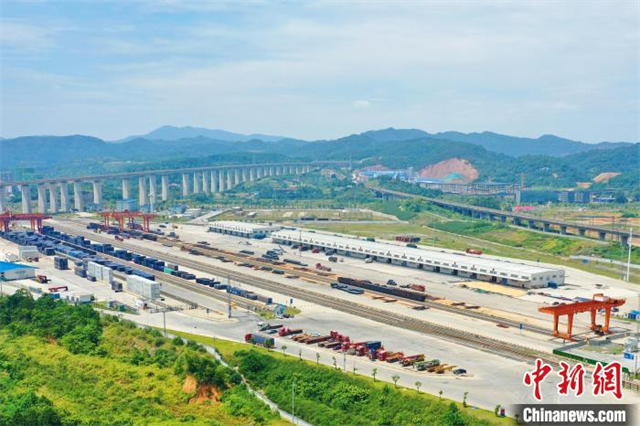Huaihua City, the only international freight assembly center in Hunan Province connecting to ASEAN countries, has been given all-out efforts to accelerate the international land port construction. The goal is to create a landmark project of reform and opening up hub in inland areas of China. The Huaihua International Land Port witnessed 272 freight train trips from January to August this year, a year-on-year increase of 209%. There were 233 rail-sea intermodal trains, 29 China-Laos trains, and 10 China-Vietnam trains. Those trains transported 13,610 TEUs of about 382,000 tons of goods, with a total value of about 1.34 billion yuan.

A total of 272 international freight train trips were made at the Huaihua International Land Port in the first eight months of this year. (Photo/Zhang Zhuo)
The Huaihua International Land Port has regularized the operation of China-Laos and China-Vietnam cross-border trains, and rail-sea intermodal foreign trade routes to Beibu Gulf Port, Zhanjiang Port, and Nansha Port. Bags, tapioca starch, chemical products, miscellaneous daily necessities, steel, and other products accounted for a growing proportion.
Since the beginning of this year, Huaihua has strengthened coordination with cities (prefecture) across Hunan Province. It has assembled cargos to the Huaihua International Land Port, including ammonium sulfate and sodium metabisulfite from Yueyang, steel from Xiangtan, rice milling machine from Loudi, and second-hand automobiles and chemicals from Zhuzhou, which will then be exported to Laos, Vietnam, Ghana and other countries. Meanwhile, it has enhanced connection with the enterprises with real achievements in trade inside and outside Huaihua City, and signed international transportation agency agreements with 26 enterprises.
Huaihua has a part in jointly building the New International Land-Sea Trade Corridor. It has been striving to achieve high-quality development and enhance high-level opening up of Huaihua International Land Port, to boost faster progress of export-oriented economy of Hunan and the central regions of China.
This article is from the Hunan Provincial Government www.enghunan.gov.cn.
Translator: Yu Jiangjiang
Chinese source: Chinanews
来源:Chinanews
编辑:谭婕倪
 时刻新闻
时刻新闻